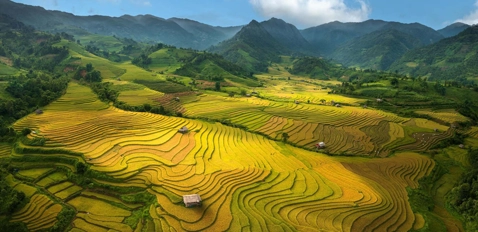Thien Mu Pagoda in Hue : the 400 Year Old Pagoda in Vietnam
Situated on the banks of the Perfume River in the culturally rich city of Hue, Vietnam, Thien Mu Pagoda is one of the oldest and most iconic Buddhist pagodas in the country, dating back to the 1600s. In this article, let’s embark on an enlightening exploration of Thien Mu Pagoda, unraveling the legends, architectural wonders, and serene landscapes that make this destination a must-visit in the mesmerizing city of Hue.
Where Is Thien Mu Pagoda In Hue ? How To Get There?
Thien Mu Pagoda is situated at Ha Khe Hill, on the northern bank of the Perfume River, in the Huong Long Ward, Hue.
Getting to Thien Mu Pagoda is pretty easy since it’s only 5km away from the city center. You can choose to travel by motorbike, bus, cyclo or join a tour. Thien Mu Pagoda is also accessible by boat. A Thien Mu Pagoda boat ride takes around 30 minutes and costs about 15$.
Thien Mu Pagoda’s Legend Story
Centuries ago, during the early 17th century, Lord Nguyen Hoang, the first lord of the Nguyen Dynasty and ruler of the southern regions of Vietnam, sought to find a suitable location to build a temple. He wanted a place that would be spiritually significant and contribute to the prosperity of his reign.
One day, as Lord Nguyen Hoang was traveling along the Perfume River, he noticed a hill rising beside the clear and meandering waters. This hill, known as Ha Khe, had a shape resembling a dragon turning its head back. Nguyen Hoang explored the hill and was Intrigued by its beauty.
Around the same time, local residents spoke of a mysterious old woman who wore a red robe and had a benevolent demeanor. Every night, she climbed to the hill and delivered a message to the people, saying that a noble lord would construct a pagoda there to safeguard the dragon's vein.
Feeling a connection between the old woman's message and his vision for the temple, Lord Nguyen Hoang decided to act. He immediately ordered his troops to build a pagoda on Ha Khe hill in 1601. This pagoda was named "Thien Mu Tu", which translates to "Pagoda of the Celestial Lady".
History Of Thien Mu Pagoda In Hue
Thien Mu Pagoda, also known as Linh Mu Pagoda, has a rich history that spans over four centuries. Thien Mu Pagoda was founded in 1601 by Nguyen Hoang, who ruled Vietnam from 1802 to 1945. The pagoda was originally built as a small temple named "Huong Tra" on Ha Khe Hill, overlooking the Perfume River.
Over the years, the pagoda underwent several expansions and renovations. In 1665, Lord Nguyen Phuc Tan expanded the temple and renamed it Thien Mu, meaning "Heavenly Lady."
In 1862, during the reign of Emperor Tu Duc, in the hope of having a male heir, the king, fearing that the word "Thien" (Heaven) might offend the gods, changed the name from "Thien Mu" to "Linh Mu" (Sacred Lady). It wasn't until 1869 that the king reverted to the original name "Thien Mu". Nowadays, people still use both names when referring to this pagoda.
Thien Mu Pagoda gained international attention in 1963 when Thich Quang Duc, a Buddhist monk, drove from Saigon to the pagoda and self-immolated in protest against the South Vietnamese government's anti-buddhism policies. The car used by Thich Quang Duc on the day of his self-immolation is still preserved on the pagoda grounds.
What To See At Thien Mu Pagoda In Hue ?
From a distance, the temple grounds take on the shape of a giant turtle carrying on its back the ancient and venerable temple, seemingly sipping water from the Perfume River.
Thien Mu Pagoda is divided into two areas. To make it simple, imagine the front area as the turtle's head, which houses the Phuoc Duyen Tower, stone steles, and the bronze bell; and the rear as the turtle's body, with the Sanctuary Hall. These two areas are separated by the Tam Quan Gates.
Phuoc Duyen Tower
Phuoc Duyen Tower is probably the thing that comes up when you google an image of Thien Mu Pagoda. It’s a 21-meter tall tower comprising seven stories, each adorned with Buddha statues. Inside, there is a spiral staircase leading to the top.
On each level of the tower, there are windows adorned with curved bronze bars, allowing light to come in. Standing on the highest level of the tower, you get a panoramic view of the Perfume River and the distant Truong Son mountain range.
To the left of the Tower is Dai Hong Chung, a pavilion that houses the huge bronze bell, weighing over 2,600 kilograms. To the right of the Tower is the stone stele set on a marble turtle.
Tam Quan Gates
This is the main entrance of the temple, located behind the Phuoc Duyen Tower. The gate has three pathways, symbolizing the Sky, the Earth, and Man. The gate is designed with two levels and eight roofs. On the second level of the central gate, there is an altar dedicated to Buddha. The top of the roofs is adorned with unique and intricate floral patterns. On both sides of the pathways, Guardian statues are placed.
Sanctuary Hall / Dai Hung Palace
Situated right in the central hall of Thien Mu Pagoda, the Dai Hung Palace is a place of worship for Buddha Maitreya, the deity symbolizing boundless joy and carefreeness. The sculpture of Buddha Maitreya depicts a gentle appearance, large ears signifying profound understanding, a generous belly symbolizing tolerance, and a friendly smile. The palace is entirely constructed from specialized concrete and painted to resemble wood.
Moving deeper inside, the main sanctuary hall features the Three Buddhas statue at the center, with Van Phu Bodhisattva on the left and Pho Hien on the right. Notably, the land behind Dai Hung Palace serves as the resting place of Venerable Thich Don Hau, the abbot of the pagoda.
The Austin Car
A rather interesting and unexpected feature of the complex would be the Austin motor vehicle left by the late Buddhist monk Thich Quang Duc.
In the 60s, the South Vietnamese government, led by President Ngo Dinh Diem, was predominantly Catholic. Diem's administration was accused of favoring Catholics over Buddhists in various aspects of public life, including government positions and allocation of resources. Buddhist discontent with the government's policies had been simmering for some time, and there were protests and demonstrations calling for religious equality.
On June 11, 1963, Thich Quang Duc, drove to Thien Mu Pagoda from his temple in Saigon in his pale blue Austin car, calmly sat down in the lotus position in the middle of the intersection, and set himself on fire. All that’s left is the old car, which is now displayed at Thien Mu Pagoda.
Visiting Thien Mu Pagoda In Hue
Thien Mu Pagoda Entrance Fee: Free
Thien Mu Pagoda Opening Hours: 08:00 AM - 06:00 PM
Is there a dress code for Thien Mu Pagoda: While there may not be an extremely strict dress code, it is recommended to dress modestly and respectfully when visiting Thien Mu Pagoda, like many other religious sites. Wear clothing that covers your shoulders and knees. Avoid clothing that is too tight, sheer, or revealing.
Send us your comments about : Thien Mu Pagoda in Hue : the 400 Year Old Pagoda in Vietnam
Required fields *
You might also be interested
Travel ideas
Need some inspiration? Discover some of the best tours in Vietnam, which are highly appreciated by our clients. An excellent starting point to help you choose the right trip to Vietnam, Laos, Cambodia, Burma or Thailand, whether you are traveling alone, as a couple, as a family or with friends.
And because this trip is yours, feel free to customize it as you wish!
Vietnam Cambodia Itinerary 14 Days
Hanoi – Hoa Binh – Mai Chau – Ninh Binh – Halong bay – Hue - Danang – Hoian – Saigon – Ben Tre - Can Tho – Saigon - Siem Reap Angkor - Tonlé Sap - Siem Reap – Ta Prohm - Departure
Vietnam 14 Day Itinerary
Vietnam 14-day itinerary covers the country’s top highlights and quintessential experiences for an unforgettable journey.
Honeymoon Tour Pakcages In Vietnam 12 Days
Saigon Arrival - City Tour – Mekong Delta – Danang – Hoian - by flight - Da Nang – Hanoi - by flight – Halong - overnight on junk – Departure
Authentic Hoang Su Phi Trekking Tours
Hoang Su Phi trekking tours take you to stunning terraces, meet few tourists, connect with locals and enjoy authentic culture.
Best Nha Trang Beach Tour 4 Days
Saigon/Hanoi – Nha Trang relaxation – Saigon/Hanoi – Departure
Mekong Delta Bike Tour Itinerary 7 Days
Cycle through the Mekong Delta in 7 days, discovering floating markets, orchards, craft villages, and tranquil green islands.
Are you interested in this tour?



























Comment